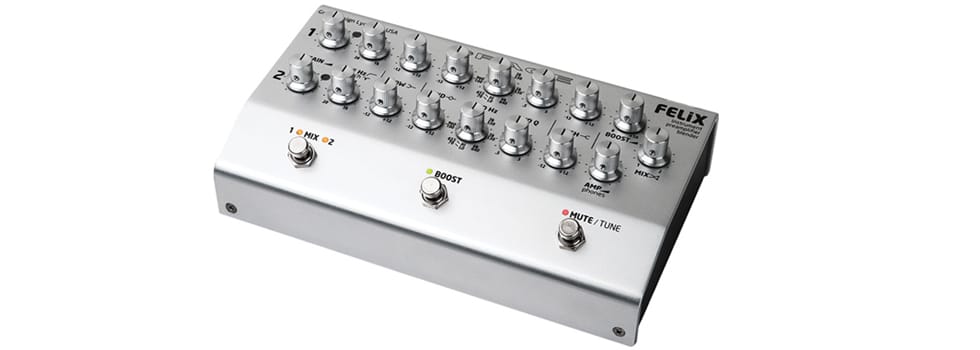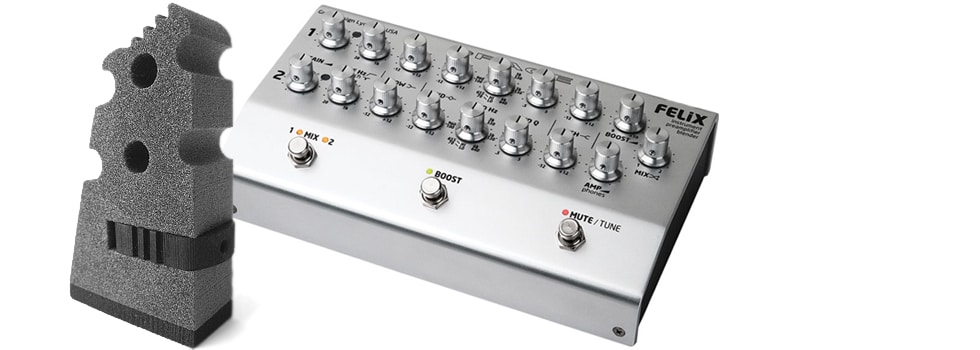Image by Piro Patton | Linked source: Talkbass.com
The secret recipe of creating an ultimate bass sound
Like any good cook, the secret of creating a good meal is first of all choosing the right ingredients and the
same way of thinking should be taking into consideration when it comes to the choice of audio equipment.
The American bass player Piro Patton explains one way of how to create an ultimate sound reproduction of
an upright bass at live gigs – so let’s talk bass.
REMIC RED & FELiX
I recently started a new thread on Talkbass.com, because I’ve found two products which together make
great companions and because together they push upward upright bass amplification’s to the highest practical ends.
Let’s start from the beginning of the signal chain, capturing the sound of the instrument.
The Remic Red mic (D5400) although not as feedback resistant as the Remic Green model (D5400LB),
sounds like a recording microphone (as present and rich as a good condenser) and can achieve on its own enough volume and presence to play a lot of gigs.
For all the old school mic only guys, this mic is going to be the one, once it gets into a few more hands.

Unlike it’s best rival the DPA 4099 shotgun, the Remic RED IS a recording mic and sounds so much better,
and is compliant to a lot of eq-ing while still sounding good and having a high feedback resistance, for example rolling off a lot of bass HPF when mixing with a pickup.
I played with the combination in several different environments from a duo concert (piano and Bass) to a
very loud very fast jazz gig in a loud bar. The Remic RED (D5400), has more gain than any mic I have ever used.
I also monitored and compared the Remic D5400 against the DPA 4099B and listening just through headphones to the two through the Felix.
I discovered that the Remic has way more gain and something else too: the DPA 4099 seems to take a little
slice of what is coming off the surface of the bass and amplify it.
Through a speaker it gives a nice mic sound but with a lot of reflection in the sound (reflection of extraneous
noises bouncing off the surface of the instrument.) But the Remic has a much richer fuller sound….there is
still some bleed from the house (and reflection) but as soon as you start to play, this is swallowed up by the real BASS GAIN of the Remic. This was very important because the mics perform fundamentally different.
I have been playing gigs with the Remic for about six months now and I either mix the Remic with a pickup
through the AI Focus or the Headway EDB1, or both actually because the pickup sounds better through the
EDB1 while the mic requires 48 Volts Phantom and while it works with the Headway, it sounds better through the Focus.
The Remic adds a deep realism and dimension to the sound that keeps me using it gig after gig, even on
noisy gigs where there is a fair amount of bleed from the Bar. Once you start playing the instrument, the
Remic picks up so much bass that the bleed is easily overcome.
The Remic has a mix of two sound sources, one a channel in the foam that takes a near (but not quite)
contact sound from the surface of the instrument (like an EAP) through the foam and another
perpendicular channel that pics up sound resonating in the few inches in front of the instrument.
The Remic can be placed either under the fingerboard, between the feet of the bridge or behind the
tailpiece, all three yield excellent but different sounds.
The Remic just delivers….every previous mic I have tried: DPA 4099, ATM 35, Troll, mini mics, dynamic mics,
etc, gets to be too much of a pain in the ass after a while and I stop using it.
Too many rooms where it can’t work, too many cords and stuff hanging on the bass, too much feedback
(my ears can’t take the feedback any more) but the Remic is demure: a sliver of a foam wedge that hides
behind the tailpiece or fingerboard and makes no noise, the cord is soft cotton so there is never any handling noise.
I have to say too that the 4099 has way way more handling noise. The 4099 is always making some
unpleasant noise on my bass either from the mounting or the cord dangling on the bass or the gooseneck bumping the bridge. The Remic is dead silent…
THE FELiX (a great companion)
The Grace Design, Felix is a two channel studio preamp in a rugged well thought out floor based design that
creates a sonic presence that is just beautiful.

The mic channel is their well known Grace m101 mic preamp, and the Felix has every configuration that you
could possibly need as a string player to mix pickup and mic (or two pickups) at the highest most musical quality.
From the moment you plug it in, you can hear why it is twice the cost of other preamps, it creates a clear
pure sonic picture (similar to listening back in a recording studio) that is amplify-able.
The Felix is such a great piece of kit that I think it should be recommended for all musicians playing violin, cello or upright bass.
Here’s a hint for those musicissians working with ONLY the Remic, the GRACE m101 Preamp is the mic
preamp within the Felix and could be used…it is half the price, But having the ability to mix in a pickup
makes the combination for most string players, just perfect.
A PERFECT MATCH
The Remic and Felix are the ideal combination, a perfect match. What the Felix adds to the Remic is both a
vast toolkit for shaping the sound almost any way you want, but also a kind of sonic space (sounds and feels
like the mic is in a padded sound controlled studio) that for live work is just brilliant.
The Remic through the Felix has just what it needs to shine.
These two products together cost that much too. This combination is not for the faint of heart. The Remic is
$900. and the Felix is about a grand. And you still need an amp or PA. But what you can do is pretty amazing.
Every musician who heard my rig in the last two weeks said something and noticed the extraordinary sound.
Again, the FELiX is a perfect match for the Remic. ITs mic channel, is just superb, clear, present, with a
presence like a medium sized well padded studio room. It presents the sound of the Remic in way that is
super musical, and that is just flat natural, turning it on for the first time.
With the excellent HPF alone a wide variety of useful variations are easily dialed up from a lot of deep
bass to a clear open but bass reduced tone (good for mixing the bottom end of the pickup in).
The eq I haven’t fully explored, partly because flat sounds so good and partly because (particularly on the
pickup channel) it didn’t seem to have great effect, so had better read some on how to use the parametric mid eq.
The Pickup channel sounds really excellent, with different impedance settings (which have a big effect) and
phantom options (you can use a Schertler or other 12volt phantomed pickup without an extra box…big plus)
BUT, if I was not so into this mic, and just using a pickup I don’t think I would spend a grand for just the
pickup preamp. What makes this a great preamp and worth the money is that it makes using a mic with a
really excellent usable sound a real possibility on every gig.
Having the Felix on the floor is a great idea. Within a minute I was already using the mute switch with my
foot instead of reaching up to the little button on the amp. While I have never thought of using one, the
boost switch seems really musical for those inclined…It amps the sound in a linear way so it does not feel
artificial. Don’t know if I would use it but…
I am super committed to the MAS 46 that Mike made me, it sounds just superior to anything else I have tried
and having the preamp on the floor means short cables from the bass, and only one to the amp, clean,
uncluttered and not too many gain stages or things to mess up.
AT THE GIG
The truth is, that I have never had a better bass sound. At the loud quartet gig I did on Sunday we were
playing full out modern Jazz loud and I was able to have the Remic far forward in the mix (at least 50%)
with the Notch filter engaged I was able to tame feedback for that extra amount of gain. At one point I
asked another bass player to play a song so I could hear the rig from the audience and it was exceptional
and even from out in the street I could clearly hear the MIC TONE of the bass with all its dimension.
The QUALITY of the sound is what is important to note. The Remic does not change TONE when it gets
louder. My drummer immediately noticed the sound of the mic and the DIMENSION that it added to the
sound, the acoustic resolve, like a great camera lens. The way the two units work together is just stunning.
But the fact is each unit by itself is also stunning. I want the Felix bad because it is the perfect preamp, but the Remic ALSO sounds great through
the other lesser preamps that I have. I guess I just want to really clarify that these two units are top notch and perfect together but the Remic is
really what makes the sound.
Also the way that the Felix blends the pickup and mic allows the player to maximize the mic sound: first you
dial in the perfect sound and gain of each (pickup and Mic) then you have a BLEND knob. This is so excellent
because it allows you to shift the amount of mic VS. pickup WITHOUT changing the gain structure that you
have set up for each separately. So on stage when it gets loud instead of dialing back the mic, you CHANGE
the MIXTURE of the blend. This allows the mic to stay at its optimal gain. It may seem like a small thing
but it is not.
It allows the mic to remain the main part of the sound with the pickup taking over the clarity and bottom
when needs be but without dialing OUT the mic. Very cool and for a string player interested in maintaining a
consistent acoustic sound, it is just stellar….
You can follow the thread on: Talkbass.com
You can find more info on FELiX here
Lets talk bass, LET’s TALK BASS!, grace design, felix, remic, microphones, bass microphone, double bass microphone, upright bass microphone, d5400, remic microphones, best bass microphone,
grase design, felix, piro patton, thorkild larsen, not piezo pickup, condenser microphone, instrument microphone

